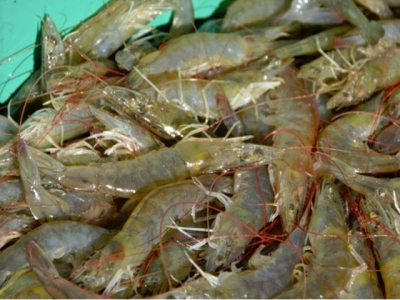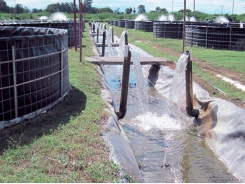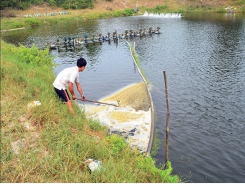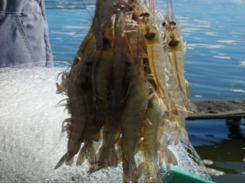Intensive production of Pacific white shrimp in a photo-heterotrophic, hypersaline system 2

Bio-economic modeling shows positive economic results and demonstrates technology potential
The photo-heterotrophic system used in this study is a bio-secure strategy for production of high-quality shrimp under hypersaline conditions in semiarid regions in northwestern Mexico.
In part 1 of this article we summarized the results of a study that evaluated the potential for intensive production of L. vannamei in hypersaline, lined ponds with photo-heterotrophic system conditions and limited seawater replacement.
Here in part 2 of this study, summarized from the original publication (doi: 10.1111/raq.12252) we report on the bioeconomic analysis we carried out by comparing the spring-summer, and the summer-autumn production cycles. Our main objective was to evaluate the productive and economic performance of shrimp in our production system, evaluating uncertainty in production and economic indicators and defining optimal harvesting strategies. There are some bioeconomic studies reported for semi-intensive and intensive shrimp cultivation in Mexico, but there are no publications yet of such a bioeconomic analysis of biosecure outdoor systems and with minimum water replacement.
The technical assistance of Jesus Aguilar at CIBNOR is acknowledged. This research was financed by FINNOVA project #192666 awarded to author Dr. Humberto Villareal. Luis D. Moreno-Figueroa is a recipient of a student fellowship from the Consejo Nacional de Ciencia y Tecnología of Mexico (CONACYT).
Study setup
In this part 2, we used a bioeconomic approach to analyze the production and economic performance of Pacific white shrimp (Litopenaeus vannamei) reared in a photo-heterotrophic, hypersaline intensive system with minimal water replacement during spring-summer (SS) and summer-autumn (SA) production cycles in the semiarid region of Baja California Sur, Mexico.
Our bioeconomic model comprised three sub-models – biological, feed conversion ratio and economic – and was calibrated using production and zootechnical data from the six ponds in both production cycles. The biological sub-model was used to predict, as a function of time, shrimp biomass as the product of the individual mean weight of shrimp and the number of shrimp surviving to harvest.
For detailed information on the experimental setup; water quality monitoring; shrimp source, nursery and feeds; the bioeconomic model, stochastic elements and variability used; the Monte Carlo simulation and sensitivity analysis; and the statistical and sensitivity analyses performed, refer to the original publication.

View of two experimental ponds used in the study.
Results and discussion
The simulated economic outcome of six ponds showed that the coefficient of variation of mean net revenues decreased from 0.67 to 0.27 (spring-summer) and from 0.31 to 0.11 (summer-autumn). Therefore, for a six-pond farm we calculated there is 95 percent confidence that the shrimp production system could generate $6,260 to $8,760 per hectare (mean = $12,600/ha) for the spring-summer cycle, and $28,520 to $45,700 per hectare (mean = $38,930/ha) for the summer-autumn cycle. Consequently, there is 95 percent confidence that the production system tested could generate $40,100 to $60,800 per hectare (mean = $51,530/ha), with an annual benefit-cost ratio between 3.08 and 3.56 (mean = 3.32). Table 1 shows the total operating costs for each cycle at the end of the study.
Villareal, hypersaline part 2, Table 1
| Operating costs ($.ha) | Spring Summer cycle | % | Summer Autumn cycle | % |
| Feed | 2470.40 | 63.9 | 3067.30 | 70.3 |
| Postlarvae | 451.20 | 11.6 | 451.2 | 10.3 |
| Personnel | 248.40 | 6.4 | 217.70 | 4.9 |
| Aeration | 214.60 | 5.5 | 149.4 | 3.4 |
| Maintenance | 271.10 | 7.0 | 217.10 | 6.2 |
| Harvest | 174.90 | 4.5 | 174.90 | 4.0 |
| Probiotics | 21.40 | 0.5 | 18.90 | 0.4 |
| Fertilizer | 5.80 | 0.1 | 5.80 | 0.1 |
| Water recovery | 4.70 | 0.1 | 4.10 | 0.1 |
| Pond preparation | 2.90 | 0.1 | 2.90 | 0.1 |
| TOTAL | 3,865.40 | 100 | 4,363.40 | 100 |
Table 1. Total operating costs calculated with the bio-economic model at the end of the cultivation cycles (adapted from original publication).
Biomass production simulation indicated with 95 percent confidence that final yield in the summer-autumn cycle could vary from 16.78 to 18.54 metric tons (MT) per hectare (mean = 17.73 MT/ha). The optimum harvesting times for both cycles were 90 and 92 days, when net revenue and the benefit-cost ratio were maximized.
Results from the sensitivity analysis of net revenue showed that the stochastic variability of prices for 13- and 14-gram shrimp (spring-summer cycle) and 18- and 19-gram shrimp (summer-autumn cycle) are the most important factors influencing net revenue variability. The random variability of the price of post-larvae (spring-summer cycle) had intermediate importance in influencing net revenues. Final shrimp weight was the most relevant biological parameter, while mortality rate had low or insignificant relevance in both cycles. Water quality parameters had an intermediate influence on the economic performance of the system.
Our results support the reported physiological resilience of L. vannamei photo-heterotrophic cultivation in open-air systems in semi-arid or arid regions with high evaporation rates, water temperatures and salinities. Sensitivity analysis showed that the stochastic variability of dissolved oxygen had a moderate influence on economic outcomes, indicating the effectiveness of artificial aeration for maintaining stable and homogeneous conditions among ponds.
Our results indicated better economic performance of the shrimp production system during the summer-autumn cycle when compared with during the spring-summer cycle. The main factors determining this result were faster shrimp growth rate in summer-autumn (1.4 grams per week) than in spring-summer (0.9 grams per week) and higher sale prices at harvest in November compared with those in August. The operating costs were similar among the production cycles, except for feed cost, which was higher in the summer-autumn cycle as a consequence of the higher amounts of feed required to support a larger shrimp biomass.
In Mexico, semi-intensive shrimp farms typically produce net revenues from $730 to $2,500 per hectare. We estimated that net revenue from our production system is about five times higher in the spring-summer cycle and 15 times higher in the summer-autumn cycle than the profits typically produced by semi-intensive farms. However, more research is needed to fully demonstrate the economic feasibility of our production system.
We estimated a significant risk reduction when scaling up from one to the six ponds used in the study. Our results showed that the net revenues’ coefficient of variation was reduced by 40.9 and 35.5 percent for the spring-summer and summer-autumn cycles, respectively, and that the probability for economic losses in the spring-summer cycle went down to 4.2 percent.
The economic performance of shrimp farming is very dependent on annual shrimp price variability, and this relevance indicates that shrimp prices should be surveyed weekly and not monthly by shrimp producers. Our sensitivity analysis showed that shrimp price was the most important factor influencing net revenue for both cycles.
Our highest value of net revenue for the spring-summer cycle resulted after 90 days of culture, because prices for 11-gram shrimp were 5.7 percent higher than for 12- to 13-gram shrimp. By harvesting at the optimum time (90 days), a mean net revenue of $12,840 per hectare resulted, 1.9 percent higher if harvesting at the end of the cycle. However, the best strategy for the summer-autumn cycle was harvesting at the end of the scheduled production cycle, indicating the convenience of extending the cycle in future production trials to evaluate if the economic benefit can be enhanced.
We recommend additional research to better understand shrimp pricing and to outline long-term harvesting strategies. The economic outcomes of other studies have shown a high sensitivity to shrimp final weight, ascribed to the amplifying effect the relationship shrimp sale price and shrimp size has on income. Our results showed that the feeding costs represented 64 percent (spring-summer cycle) and 70 percent (summer-autumn cycle) of total operating costs, in the range of the typical 60 percent reported for shrimp farming in general.

View of the shrimp harvested at the end of the study.
Perspectives
Based on our study results, we conclude that the photo-heterotrophic system is a bio-secure strategy for production of high-quality shrimp under hypersaline conditions in semiarid regions in northwestern Mexico. The stochastic bioeconomic approach is an effective tool to analyze the economic performance, uncertainty and optimal harvesting strategies of the cultivation system.
We recommend further investigations of the aptness of the culture technology we used – based on our positive economic results – as an alternative for shrimp production in semiarid and arid regions.
Related news
Tools

Phối trộn thức ăn chăn nuôi

Pha dung dịch thủy canh

Định mức cho tôm ăn

Phối trộn phân bón NPK

Xác định tỷ lệ tôm sống

Chuyển đổi đơn vị phân bón

Xác định công suất sục khí

Chuyển đổi đơn vị tôm

Tính diện tích nhà kính

Tính thể tích ao




 A new candidate for commercial aquaculture?
A new candidate for commercial aquaculture?  Intensive production of Pacific white shrimp in a…
Intensive production of Pacific white shrimp in a…